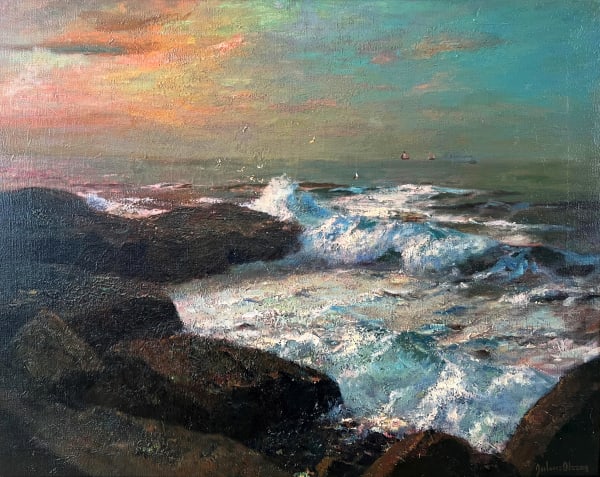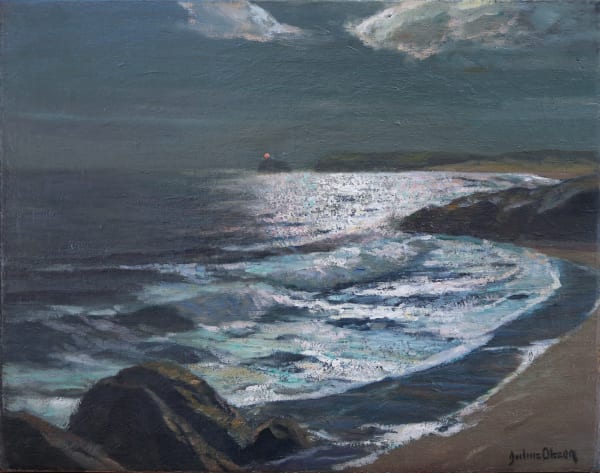Julius Olsson, St Ives artist, 1864 - 1942
-
 Julius OlssonLast EmbersOil on canvas61 x 76cm (24 x 29 15/16ins.)
Julius OlssonLast EmbersOil on canvas61 x 76cm (24 x 29 15/16ins.)
Framed: 83.8 x 99.7cm (33 x 39 1/4ins.)View full details -
 Julius OlssonEvening shipping across Carbis Bay, c. 1910Oil on canvas60.9 x 76.2 cm (24 x 30 ins.)Sold
Julius OlssonEvening shipping across Carbis Bay, c. 1910Oil on canvas60.9 x 76.2 cm (24 x 30 ins.)Sold
Framed: 83.8 x 99.0 cm (33 x 39 ins.)View full details -
 Julius OlssonStormy Evening on the Cornish Coast, 1912Oil on canvas139 cm x 183 cm (54.7 x 72 ins.)
Julius OlssonStormy Evening on the Cornish Coast, 1912Oil on canvas139 cm x 183 cm (54.7 x 72 ins.)
Framed: 161 cm x 204 cm (63.4 x 80.3 ins.)View full details -
 Julius OlssonMoonlit Fleet in St Ives Bay, c. 1911Oil on canvas45.7 x 61 cm (18 x 24 ins).Sold
Julius OlssonMoonlit Fleet in St Ives Bay, c. 1911Oil on canvas45.7 x 61 cm (18 x 24 ins).Sold
Framed: 59.7 x 74.9 cm (23 1/2 x 29 1/2 ")View full details -
 Julius OlssonSt Ives Bay, MoonlightOil on canvas35.5 x 45.7 cm (14 x 18 ins)Sold
Julius OlssonSt Ives Bay, MoonlightOil on canvas35.5 x 45.7 cm (14 x 18 ins)Sold
54.7 x 64.7 cm (21.5 x 25.5 ins)View full details -
 Julius OlssonMoonlit SkyOil on canvas60.9 cm x 76.2 cmSold
Julius OlssonMoonlit SkyOil on canvas60.9 cm x 76.2 cmSold
Framed: 77.0 cm x 92.2 cmView full details
"… for one whose heart draws him to the sea must have an exceptionally retentive memory, and be able to grasp in a few moments the effect of the ever-changing movements of the sea and sky; he must have a delicate sense of colour, and have the ability to place the main features of his impression on the canvas with a few strokes." Julius Olsson.
’A “big man with a big heart, who paints big pictures with big brushes in a big studio.“ He did more than any other painter to stamp St Ives as a British outpost of impressionism.’ (Folliott Stokes and Cornwall Artists’ Index). Olsson’s distinct genius was his ability to grasp in a few moments the ever-changing movements of the sea and transfer his precise memory boldly, in paint to canvas.
Julius Olsson was born to a Swedish father and English mother in 1864 and brought up in Islington, London. Olsson showed an early talent and was largely self-taught, although he was later to become the founding father of the St Ives School of painting and mentor to many successful St Ives artists. The Cornwall Artists Index notes the probable first record of Olsson in Cornwall; ‘in 1887 at the Nineteenth Century Art Society, which kept a small gallery at Dudley, West Yorkshire, “Mr J Olsson shows a distinct poetic feeling in his treatment of March Twilight: Newlyn, Cornwall.”’
A few years later, after some initial training in London and abroad, Olsson came to St Ives at the age of 26. Olsson swiftly established himself as an artistic force to be reckoned with in St Ives. As early as May 1889 the Daily Telegraph suggested that Louis Grier and Julius Olsson were building up what one day might be recognised as the St Ives School of Painting.
In the 1890s Olsson exhibited with the Newlyn painters. His first painting to be exhibited at the Royal Academy was ‘Sea Breezes’ in 1890. He was to become one of Academy’s most prolific artists exhibiting a lifetime’s 175 paintings at RA Summer Exhibitions. Prior to their dispatch for judging at the Royal Academy, the people of St Ives and Cornwall had a chance to measure the talent of that year’s artistic output at ‘Show Day’. Members of the St Ives Art Club would exhibit, in their Downalong Studios, the works they planned to submit to the Royal Academy Summer Exhibition. Special railway carriages were laid on to bring visitors to the open studios, and later to take the paintings up to London. In 1891 Olsson joined the New English Art Club.
6 years after the Telegraph’s prescient article, Olsson and Grier started to take on students in 1895, soon afterwards forming the Cornish School of Landscape, Figure and Sea Painting in St Ives. Grier was later replaced by Algernon Talmage but Olsson was always the driving force. He was a hard task master sending his students out in all weathers to paint around St Ives harbour. There are some wonderful photographs of his students, who referred to him as ‘Jo’, holding onto their heavy wooden easels, in full Victorian garb, being thrashed by a winter storm but pressed on by their unperturbed and unrelenting mentor. In the same year Olsson was first elected President of the St Ives Arts Club. He was to be elected its President 3 times.
Looking at a mature work by Julius Olsson one has to marvel at his ability to capture in oil paint a millisecond’s drama and kaleidoscope of light and shadow in crashing waves and explosive surf, years before the aide-memoire of even a rudimentary colour photograph was available (1907). The qualities required to be Julius Olsson, marine artist, are best summarised, inadvertently, by the man himself: ‘… for one whose heart draws him to the sea must, in the first place, have an exceptionally retentive memory, and be able to grasp in a few moments the effect of the ever-changing movements of the sea and sky; he must have a delicate and subtle sense of colour, and have the ability to place the main features of his impression of the subject on the canvas with a few strokes of the brush, and, besides this, he must be prepared to fight the brave fight with the elements, which will be frequently against him.’ (Olsson’s forward to ‘The Technique of Seascape Painting’ by, Borlase Smart).
In St Ives, with his artist wife Kathleen, he designed in the Arts and Crafts style, his new home St Eia (later a hotel and today, residential). St Eia enjoyed views north to St Ives Harbour and overlooked Carbis Bay to the east. During Olsson’s time there it was to house a studio and become a school of art; he taught many future St Ives artists of renown including John Anthony Park, Mary McCrossan, Richard Hayley Lever and Robert Borlase Smart.
In St Ives, Olsson also painted in No5 Porthmeor Studios (former sail and net lofts) above Porthmeor beach. Later resident painters in No5 were Ben Nicholson, Patrick Heron and Terry Frost.
Olsson settled down to a comfortable life as artist, teacher, pillar of the community (he was a St Ives town councillor and later appointed Justice of the Peace) and keen yachtsman. He cruised his yacht most summers observing and recording the sea in its many moods. The Studio commenting: 'He knows the way from the Scillies to the Isle of Wight as most men know their way to the nearest railway station.'
Olsson was famed for his beautiful renderings of moonlit seascapes. Perhaps the most famous example of this romantic naturalism is ‘Moonlit Shore’, exhibited at the Royal Academy in 1911 and purchased by the Chantry bequest for the Tate. Emboldened by the Tate purchase, Olsson moved to London in 1912 but remained supportive and connected to the St Ives art colony for the rest of his life.
He was elected an Associate of the RA in 1914 and a full Academician after the war in 1920. In 1917 he was elected President of the Royal Institute of Oil Painters. He won two Gold Medals at the Paris Salon, was declared hors concours and was twice elected to the International Jury of the Carnegie Institute.
In 1925 Olsson married Edith Ellison, the daughter of an Irish horse breeder, and made frequent trips to Ireland painting beautiful but somewhat more serene seascapes (compared to his main body of work from the north coast of Cornwall) including sunsets off the west coast of Connemara in County Galway and even commercial commissions for the burgeoning tourism industry such as Dunluce Castle in County Antrim (London, Midland and Scottish Railway poster, 1924), still available in print.
During WW2 the Olssons' home was severely damaged in an air raid and they departed London. In 1942 Julius Olsson passed away at St Heliers, Dalkey, Co Dublin in Ireland whilst on a visit to his sister-in-law's home.
Stokes, A.G. Folliott (1910) ‘Julius Olsson: A Painter of Seascapes’, The Studio, vol. 48
Tovey, David (2008) Pioneers of St Ives Art at Home and Abroad (1889-1914)
Tufnell, Ben (2006) On the Very Edge of the Ocean: The Porthmeor Studios and Painting in St Ives








